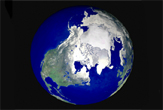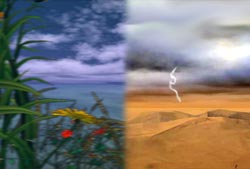The History of Climate Change Science

This is the text of an essay on the web site “The Discovery of Global Warming” by Spencer Weart, January 2007. For an overview see the book of the same title (Harvard Univ. Press, 2003).
Copyright © 2003-2007 Spencer Weart & American Institute of Physics. Reprinted here with permission.
Here are gathered in chronological sequence the most important events in the history of climate change science. (For a narrative see the Introduction: Summary History.) The list of milestones includes major influences external to the science itself.
On Weart's web site, nearly all items have links to essays.
1800-1870
Level of carbon dioxide gas (CO2) in the atmosphere, as later measured in ancient ice, is about 290 ppm (parts per million).
First Industrial Revolution. Coal, railroads, and land clearing speed up greenhouse gas emission, while better agriculture and sanitation speed up population growth.
Get the world’s most fascinating discoveries delivered straight to your inbox.
1824
Joseph Fourier calculates that the Earth would be far colder if it lacked an atmosphere.
1859
Tyndall discovers that some gases block infrared radiation. He suggests that changes in the concentration of the gases could bring climate change.
1896
Arrhenius publishes first calculation of global warming from human emissions of CO2.
1897
Chamberlin produces a model for global carbon exchange including feedbacks.
1870-1910
Second Industrial Revolution. Fertilizers and other chemicals, electricity, and public health further accelerate growth.
1914-1918
World War I. Governments learn to mobilize and control industrial societies.
1920-1925
Opening of Texas and Persian Gulf oil fields inaugurates era of cheap energy.
1930s
Global warming trend since late 19th century reported.
Milankovitch proposes orbital changes as the cause of ice ages.
1938
Callendar argues that CO2 greenhouse global warming is underway, reviving interest in the question.
1939-1945
World War II. Grand strategy is largely driven by a struggle to control oil fields.
1945
U.S. Office of Naval Research begins generous funding of many fields of science, some of which happen to be useful for understanding climate change.
1956
Ewing and Donn offer a feedback model for quick ice age onset.
Phillips produces a somewhat realistic computer model of the global atmosphere.
Plass calculates that adding CO2 to the atmosphere will have a significant effect on the radiation balance.
1957
Launch of Soviet Sputnik satellite. Cold War concerns support 1957-58 International Geophysical Year, bringing new funding and coordination to climate studies.
Revelle finds that CO2 produced by humans will not be readily absorbed by the oceans.
1958
Telescope studies show a greenhouse effect raises temperature of the atmosphere of Venus far above the boiling point of water.
1960
Downturn of global temperatures since the early 1940s is reported.
Keeling accurately measures CO2 in the Earth’s atmosphere and detects an annual rise. The level is 315 ppm.
1962
Cuban Missile Crisis, peak of the Cold War.
1963
Calculations suggest that feedback with water vapor could make the climate acutely sensitive to changes in CO2 level.
1965
Boulder meeting on causes of climate change, in which Lorenz and others point out the chaotic nature of the climate system and the possibility of sudden shifts.
1966
Emiliani’s analysis of deep-sea cores shows the timing of ice ages was set by small orbital shifts, suggesting that the climate system is sensitive to small changes.
1967
International Global Atmospheric Research Program established, mainly to gather data for better short-range weather prediction but including climate.
Manabe and Wetherald make a convincing calculation that doubling CO2 would raise world temperatures a couple of degrees.
1968
Studies suggest a possibility of collapse of Antarctic ice sheets, which would sea levels catastrophically.
1969
Astronauts walk on the Moon, and people perceive the Earth as a fragile whole.
Budyko and Sellers present models of catastrophic ice-albedo feedbacks.
Nimbus III satellite begins to provide comprehensive global atmospheric temperature measurements.
1970
First Earth Day. Environmental movement attains strong influence, spreads concern about global degradation.
Creation of U.S. National Oceanic and Atmospheric Administration, the world’s leading funder of climate research.
Aerosols from human activity are shown to be increasing swiftly. Bryson claims they counteract global warming and may bring serious cooling.
1971
SMIC conference of leading scientists reports a danger of rapid and serious global climate change caused by humans, calls for an organized research effort.
Mariner 9 spacecraft finds a great dust storm warming the atmosphere of Mars, plus indications of a radically different climate in the past.
1972
Ice cores and other evidence show big climate shifts in the past between relatively stable modes in the span of a thousand years or so.
1973
Oil embargo and price rise bring first “energy crisis.”
1974
Serious droughts and other unusual weather since 1972 increase scientific and public concern about climate change, with cooling from aerosols suspected to be as likely as warming; journalists talk of ice age.
1975
Concern about environmental effects of airplanes leads to investigations of trace gases in the stratosphere and discovery of danger to ozone layer.
Manabe and collaborators produce complex but plausible computer models which show a temperature rise of several degrees for doubled CO2.
1976
Studies find that CFCs (1975) and also methane and ozone (1976) can make a serious contribution to the greenhouse effect
Deep-sea cores show a dominating influence from 100,000-year Milankovitch orbital changes, emphasizing the role of feedbacks.
Deforestation and other ecosystem changes are recognized as major factors in the future of the climate.
Eddy shows that there were prolonged periods without sunspots in past centuries, corresponding to cold periods.
1977
Scientific opinion tends to converge on global warming as the biggest climate risk in next century.
1978
Attempts to coordinate climate research in U.S. end with an inadequate National Climate Program Act, accompanied by temporary growth in funding.
1979
Second oil “energy crisis.” Strengthened environmental movement encourages renewable energy sources, inhibits nuclear energy growth.
U.S. National Academy of Sciences report finds it highly credible that doubling CO2 will bring 1.5-4.5EC global warming.
World Climate Research Programme launched to coordinate international research.
1981
Election of Reagan brings backlash against environmental movement; political conservatism is linked to skepticism about global warming.
IBM Personal Computer introduced. Advanced economies are increasingly delinked from energy.
Hansen and others show that sulfate aerosols can significantly cool the climate, raising confidence in models showing future greenhouse warming.
Some scientists predict greenhouse warming “signal” should be visible by about the year 2000.
1982
Greenland ice cores reveal drastic temperature oscillations in the span of a century in the distant past.
Strong global warming since mid-1970s is reported, with 1981 the warmest year on record.
1983
Reports from U.S. National Academy of Sciences and Environmental Protection Agency spark conflict, as greenhouse warming becomes prominent in mainstream politics.
1985
Villach conference declares expert consensus that some global warming seems inevitable, calls on governments to consider international agreements to restrict emissions.
Antarctic ice cores show that CO2 and temperature went up and down together through past ice ages, pointing to powerful biological and geochemical feedbacks.
Broecker speculates that a reorganization of North Atlantic Ocean circulation can bring swift and radical climate change.
1987
Montreal Protocol of theVienna Convention imposes international restrictions on emission of ozone-destroying gases.
1988
News media coverage of global warming leaps upward following record heat and droughts plus testimony by Hansen.
Toronto Conference calls for strict, specific limits on greenhouse gas emissions.
Ice-core and biology studies confirm living ecosystems make climate feedback by way of methane, which could accelerate global warming.
Intergovernmental Panel on Climate Change (IPCC) is established.
Level of CO2 in the atmosphere reaches 350 ppm.
After 1988 it is difficult to identify historical milestones. Not only do we lack perspective, but the effort was so large that progress on a given topic, even more than before, came through a variety of results spread over several groups and several years.
A TENTATIVE LIST:
1989
Fossil-fuel and other industries form Global Climate Coalition in US to lobby politicians and convince the media and public that climate science is too uncertain to justify action.
1990
First IPCC report says world has been warming and future warming seems likely. Industry lobbyists and some scientists dispute the tentative conclusions.
1991
Mt. Pinatubo explodes; Hansen predicts cooling pattern, verifying (by 1995) computer models of aerosol effects.
Global warming skeptics emphasize studies indicating that a significant part of 20th-century temperature changes were due to solar influences. (The correlation would fail in the following decade.)
Studies from 55 million years ago show possibility of eruption of methane from the seabed with enormous self-sustained warming.
1992
Conference in Rio de Janeiro produces UN Framework Convention on Climate Change, but US blocks calls for serious action.
Study of ancient climates reveals climate sensitivity in same range as predicted independently by computer models.
1993
Greenland ice cores suggest that great climate changes (at least on a regional scale) can occur in the space of a single decade.
1995
Second IPCC report detects "signature" of human-caused greenhouse effect warming, declares that serious warming is likely in the coming century.
Reports of the breaking up of Antarctic ice sheets and other signs of actual current warming in polar regions begin affecting public opinion.
1997
Toyota introduces Prius in Japan, first mass-market electric hybrid car; swift progress in large wind turbines and other energy alternatives.
International conference produces Kyoto Protocol, setting targets to reduce greenhouse gas emissions if enough nations sign onto a treaty.
1998
The warmest year on record, globally averaged (1995, 1997, and 2001-2006 were near the same level). Borehole data confirm extraordinary warming trend.
Qualms about arbitrariness in computer models diminish as teams model ice-age climate and dispense with special adjustments to reproduce current climate.
1999
Criticism that satellite measurements show no warming are dismissed by National Academy Panel.
Ramanathan detects massive "brown cloud" of aerosols from South Asia.
2000
Global Climate Coalition dissolves as many corporations grapple with threat of warming, but oil lobby convinces US administration to deny problem.
Variety of studies emphasize variability and importance of biological feedbacks in carbon cycle, liable to accelerate warming.
2001
Third IPCC report states baldly that global warming, unprecedented since end of last ice age, is "very likely," with possible severe surprises. Effective end of debate among all but a few scientists.
Bonn meeting, with participation of most countries but not US, develops mechanisms for working towards Kyoto targets.
National Academy panel sees a "paradigm shift" in scientific recognition of the risk of abrupt climate change (decade-scale).
Warming observed in ocean basins; match with computer models gives a clear signature of greenhouse effect warming.
2002
Studies find surprisingly strong "global dimming," due to pollution, has retarded arrival of greenhouse warming, but dimming is now decreasing.
2003
Variety of studies increase concern that collapse of ice sheets (West Antarctica, perhaps Greenland) can raise sea levels faster than most had believed.
Deadly summer heat wave in Europe accelerates divergence between European and US public opinion.
2004
In controversy over temperature data covering past millenium, most conclude climate variations were substantial, but not comparable to the post-1980 warming.
First major book, movie and art work featuring global warming appear.
2005
Kyoto treaty goes into effect, signed by major industrial nations except US. Japan, Western Europe, regional US entities accelerate work to retard emissions.
Hurricane Katrina and other major tropical storms spur debate over impact of global warming on storm intensity.
Level of CO2 in the atmosphere reaches 380 ppm.
—From “The Discovery of Global Warming” by Spencer Weart
More to Explore
What makes Earth habitable? This LiveScience original video explores the science of global warming and explains how, for now, conditions here are just right.
- Top 10 Surprising Results of Global Warming
- How You Can Fight Global Warming
- All About Climate Change

